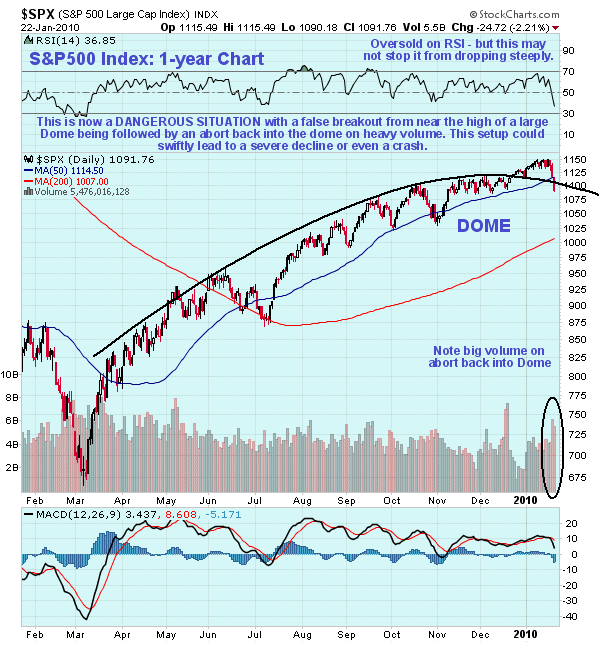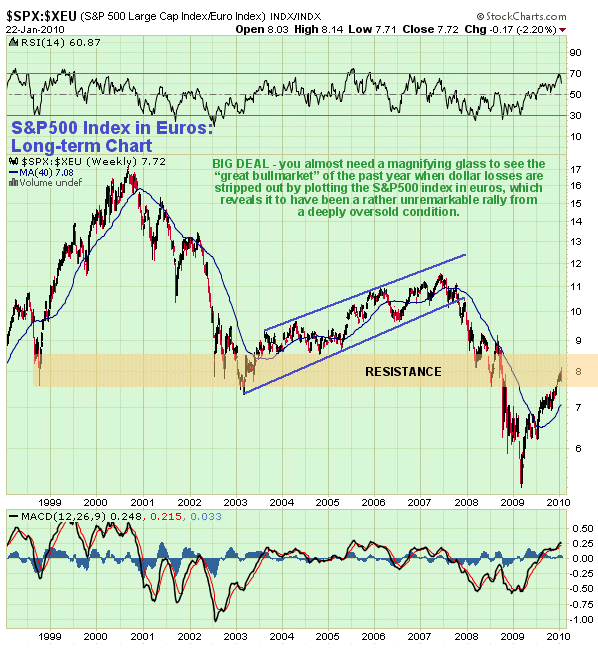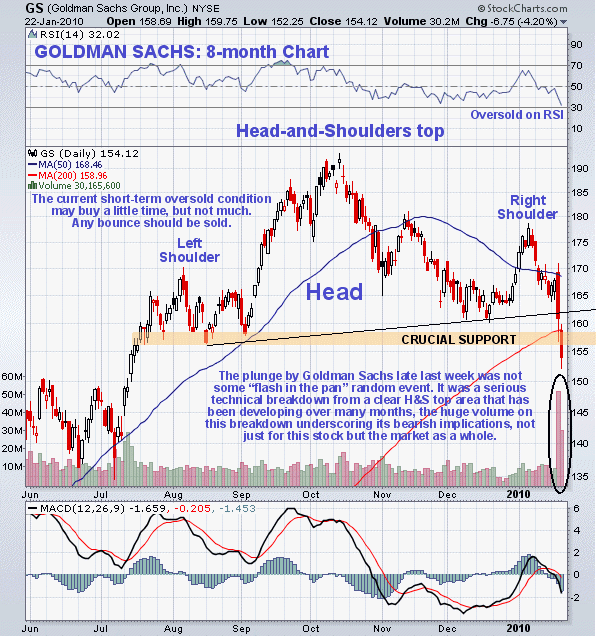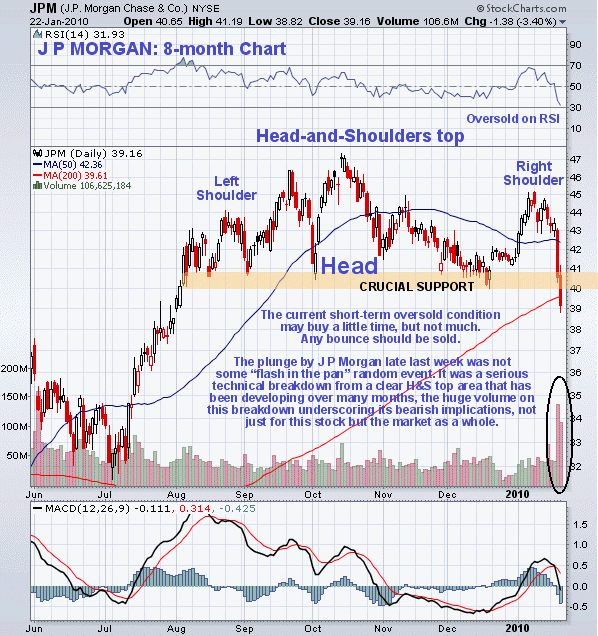Stock Market Heading for Black Monday Crash?
Stock-Markets / Financial Crash Jan 24, 2010 - 12:26 PM GMTBy: Clive_Maund
 On Friday Goldman Sachs and J P Morgan broke down decisively from their Head-and-Shoulders tops, a development that we predicted before the open based in large part on the huge downside volume in these stocks on Thursday. The Put options that we bought in the early trade in GS and JPM soared, some contracts rising by about 50% by the close. This bearish development caused shockwaves to spread through the market which accelerated to the downside late in the day. After 2 days of heavy losses the Precious Metals stocks indices stopped for a breather just above their 200-day moving averages, and closed virtually unchanged on the day.
On Friday Goldman Sachs and J P Morgan broke down decisively from their Head-and-Shoulders tops, a development that we predicted before the open based in large part on the huge downside volume in these stocks on Thursday. The Put options that we bought in the early trade in GS and JPM soared, some contracts rising by about 50% by the close. This bearish development caused shockwaves to spread through the market which accelerated to the downside late in the day. After 2 days of heavy losses the Precious Metals stocks indices stopped for a breather just above their 200-day moving averages, and closed virtually unchanged on the day.


The big question now of course is whether the broad stockmarket will accelerate into a severe decline or even a crash, which would of course take resource stocks with it. Before attempting to answer this question, we will step back and make some general observations about the "bullmarket" of the past year.
The first point we need to make about the broad US stockmarket rally of the past year is that it has been ABNORMAL and still only ranks as a bearmarket rally, rather like those that occurred in the early 30's. It certainly has not been been due to a return to anything like normal business conditions. For the most part it has simply been a bounceback relief rally from the oversold extremes resulting from the state of crisis that prevailed early last year, made possible by massive infusions of manufactured money and bailouts. The vaunted return to profitability, which was largely due to aggressive cost cutting measures rather than any broad-based recovery in demand, masks a continued state of debt-wracked atrophy across the economy. The rally has also been encouraged by a prolonged zero interest rate environment, which has discouraged saving and genuine investment and instead fuelled a massive dollar carry trade and a renewed speculative binge in commodities and stocks.
Because the United States is drowning in debt, at all levels - Federal, State, corporate and personal, rising interest rates are unthinkable and would cause immediate economic implosion. Policymakers are thus in a classic catch 22 situation, backed completely into a corner - raise interest rates to support the dollar and face economic implosion - or keep interest rates low and watch the currency and Treasury market collapse. Faced with this horrendous dilemma they are taking the only option open to them, which is to buy time. Thus they are engaged in widespread accounting fraud and obfuscation to whitewash the awful reality of the situation, and in sheer desperation are propping up the Treasury market by means of large scale monetization - and hoping that foreigners don't put 2 and 2 together. This monetisation requires the creation of money on a large scale out of nowhere and is thus highly inflationary, and represents a reckless attempt to keep the powerful deflationary forces that have been building for many years from doing their grim but necessary work of purging the economy of excesses.
The wild card in this situation is that at some point they are going to lose control - to a large extent they have lost it already and are merely reacting to events. They are taking the inflationary / hyperinflationary route because that buys them the most time and enables them to keep interest rates at zero for as long as possible - but if they lose control of the ball and the market decides that IT is going to set real world interest rates, and set them considerably higher, then the jig is up. The moment the stockmarket, which has risen in large part because of the zero interest rate environment, gets the scent of higher interest rates, it will cave in, and we may have actually arrived at the point where policymakers WANT the commodity and stockmarkets to cave in, in order that they can sluice the outpouring of funds back into the dollar and the Treasury market.
A reader wrote me that this story about Obama moving to restrict the banks was all just a bluff designed to spook the markets and shake a lot of people out of their positions ahead of another bullmarket run, and that big money would coming storming in and drive GS and JPM stock prices back up on equally impressive volume. However, this interpretation is thought to attribute too much power and control to these people. Being wealthy and having tremendous power does not necessarily make you infallible, even if everyone laughs at your terrible jokes - look at how Bill Gates and Warren Buffett lost a huge slice of their fortunes in the financial crisis - which they most certainly would have avoided if they could have gotten their hands on Biff Tannen's almanac. While anything is possible and everything may reverse to the upside and carry on happily higher as before, it certainly doesn't look like it on the charts shown below. The breakdowns in Goldman Sachs and J P Morgan are not just some 2-day wonder that came out of nowhere - they are major breakdowns from clear top patterns that have been forming from last July - August, a period of 5 to 6 months, and thus have seriously bearish implications.


The charts for Goldman Sachs and J P Morgan are remarkably similar - so similar in fact that we can save ourselves time and effort as what is written for one of them applies equally to both - so much for the fundamentals! They have both completed Head-and-Shoulders top reversals that have taken 5 to 6 months to form, and both broke down from these patterns last week on huge volume on the news of impending restrictions on banks' activities, which has major bearish implications not just for these individual stocks but for the market as whole. This is because Goldman Sachs and J P Morgan are the elite cornerstones of Wall St. They are to Wall St what the Bismarck and Prinz Eugen were to the German navy during World War 2. If they go down they will take Wall St with them and their charts are saying that this is exactly what is going to happen.
The only question now is a minor one of timing - they are both short-term oversold and close to rising 200-day moving averages and so we MAY see a feeble bounce near-term to alleviate this, which should of course be sold, or a sideways holding pattern. On the other hand with support having just failed and the entire market having accelerated to the downside during the final hour or two of trading on Friday, there is plenty for investors and traders to worry about this weekend which could easily lead to a severe decline as we go into next week, and we could conceivably witness a classic Black Monday.
Anyone wondering what effect this might have on the resource sector only has to refer to the charts for last year, which quickly reveal that when the broad market collapses it takes the resource sector with it. Precious Metals stocks broke down from their year-long uptrend last week, and are thus clearly acutely vulnerable, even if they already look oversold. We saw this coming on the site and took evasive action on Tuesday before the steep drop and breakdown occurred.
By Clive Maund
CliveMaund.com
For billing & subscription questions: subscriptions@clivemaund.com
© 2010 Clive Maund - The above represents the opinion and analysis of Mr. Maund, based on data available to him, at the time of writing. Mr. Maunds opinions are his own, and are not a recommendation or an offer to buy or sell securities. No responsibility can be accepted for losses that may result as a consequence of trading on the basis of this analysis.
Mr. Maund is an independent analyst who receives no compensation of any kind from any groups, individuals or corporations mentioned in his reports. As trading and investing in any financial markets may involve serious risk of loss, Mr. Maund recommends that you consult with a qualified investment advisor, one licensed by appropriate regulatory agencies in your legal jurisdiction and do your own due diligence and research when making any kind of a transaction with financial ramifications.
Clive Maund Archive |
© 2005-2022 http://www.MarketOracle.co.uk - The Market Oracle is a FREE Daily Financial Markets Analysis & Forecasting online publication.



